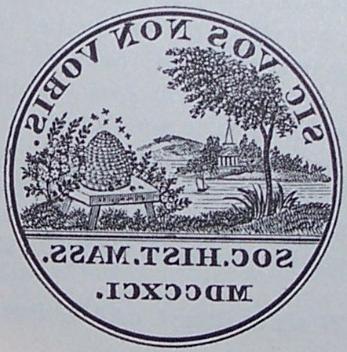By 杰里米Dibbell
If you’ve ever looked closely at the woodwork over the fireplace in Ellis Hall (better known as the Reading Room), 你也许已经注意到那里有协会的印章, 这也出现在这个博客的报头, and on the title pages of various Society publications. The design features a beehive with several honey蜜蜂 buzzing around it; an inscription above reads “Sic Vos Non Vobis” (which translates roughly to “you work, 但不是为了你们自己。”).
 我们的印章可以追溯到1833年末, when MHS President John Davis was charged by the members to “prepare a device for a seal for the Society.” Davis obliged, presenting the design in its current form on 27 February 1834. The quote is from the Roman poet Virgil’s response to another poet, Bathyllus, who had claimed credit for a pro-Caesar verse penned (and posted anonymously) by Virgil.
我们的印章可以追溯到1833年末, when MHS President John Davis was charged by the members to “prepare a device for a seal for the Society.” Davis obliged, presenting the design in its current form on 27 February 1834. The quote is from the Roman poet Virgil’s response to another poet, Bathyllus, who had claimed credit for a pro-Caesar verse penned (and posted anonymously) by Virgil.
整个答辩书如下:
他的自我是有效的, tulit alter honores; / Sic vos non vobis fertis aratra boves; / Sic vos non vobis mellificatis apes; / Sic vos non vobis vellera fertis oves; /Sic vos non vobis nidificatis aves.
也就是说, I wrote these lines; another has borne away the honor; / Thus do ye, 牛, for others bear the yoke; / Thus do ye, 蜜蜂, for others make honey; / Thus do ye, 羊, wear fleece for others; / Thus do ye, 鸟, 为其他动物筑巢.
As former MHS director Stewart Mitchell wrote in 1949, it would hardly have done to compare the members of the Society to 牛, 羊, or 鸟 … “but 蜜蜂 had always had a good reputation for the sweetness and light of their honey and their wax,” and made a fitting symbol for the Society’s mission. 根据MHS成员查尔斯·迪恩的 讲话 在1877年3月的一次协会会议上, Virgil’s line “has always been regarded as a favorite motto for quotation, 表示奉献的和无私的劳动, 也就是说, 为了别人的利益……”.
戴维斯法官的印章经受住了时间的考验, although the members briefly considered abandoning it in 1857 in favor of a new design. It was decided that “to discard [the seal] for a new one, merely because the latter is better suited to the present advanced state of art, 会为持续的变革提供一个先例吗, in order to keep pace with the progress of improvement. Such changes weaken the confirmative proof derived from a corporate seal and might even bring its identity or genuineness into question, 损害或危害公司利益的. 有, 除了, 一定程度的尊重, 通常因印章的古老而受到欢迎, 像我们这样的社会应该珍惜的利记APP官网手机版.” The source of the motto was called into question in 1881, when member Henry Haynes presented a 纸 质疑维吉尔是这首诗的作者. Haynes concluded “I fear that [our motto’s] paternity, instead of being as respectable as has been imagined, 是相当可疑的吗.” Haynes’ argument does not seem to have gained much traction, 然而, and the MHS (along with the rest of the world) continues to attribute the verse to Virgil.
有 some question, 然而, of Davis’ inspiration for the seal’s design. As early as 1791 MHS founder Jeremy Belknap had beehives on the brain: among his 纸s is a note pertaining to a seal: “For the Historical Society a Beehive – supported by two Beavers” with the motto “Nil magnum sine labore” (“nothing great is done without labor”). (It should be said that Belknap later mused about a seal which would feature “a flying eagle – a ranging wolf – and a shark – all seeking their prey.”) Belknap never formally proposed either of his ideas, and it is not known whether Davis knew of them in the 1830s.
Several other precedents for the MHS device are known, as Mr. 迪恩早在1877年就指出了. 在约翰·道顿的文学期刊上 完整的图书馆 (1692-94) a device on the title page (below left) includes a beehive and the bannered inscription “Sic nos non nobis mellificamus apes” (the line containing our motto, 转换为第一人称). And on the frontispiece to the eighth volume of John Nichols’ 文学轶事 (1814), 另一个蜂巢(右下), this one with the exact inscription later used for the MHS seal.
巧合?? 你来评判吧.


Regardless of where it came from, there you have it: the story behind 蜂巢. I think the image really does capture what we’re all about here at the MHS. 就像协会的成员一直做的那样, those of us who work here today labor not for ourselves, 但对其他人来说.
进一步阅读:
– 诉讼 of the 马萨诸塞州历史学会 第一卷(1791-1835),页. 483-488.
– Charles Deane, “Remarks on the Seal of the Society.” 诉讼 第15卷(1876-1877),页. 256-258.
– Henry Haynes, “[On the authorship of the Society’s motto.]” 诉讼 第18卷(1880-1881),页. 402-404.
——斯图尔特·米切尔 Handbook of the 马萨诸塞州历史学会, 1791-1948. 波士顿:MHS, 1949,页. 8.
——路易斯·伦纳德·塔克 The 马萨诸塞州历史学会: A Bicentennial History, 1791-1991. 波士顿:MHS, 1995, pp. 58-61.

